Gravina in Puglia, the singular history of the church with the facade shaped like a noble coat of arms
A bishop probably suffering from problems of megalomania but very shrewd and shrewd, a community of believers extremely devoted to the worship of an image of the Madonna, a large supply of money: these are the ingredients that led, in 1602, to the construction of one of the most unique churches in the world, the shrine of Our Lady of Grace (or “delle Grazie”: throughout history we have referred to the building of worship in both ways) in Gravina in Puglia. The uniqueness of this incredible monument lies in its façade: in fact, it was conceived as a huge heraldic coat of arms of the bishop who had it built, the prelate Vincenzo Giustiniani (Chio, 1550 - Gravina in Puglia, 1614), a member of the “Greek” branch of one of the most prominent families in Genoa, the Giustiniani family, which had been entrusted since the 14th century by the Compagna Communis (i.e., the republican organization of medieval Genoa) with the management of the Greek island of Chio, in ancient times a Genoese colony. The Giustiniani exercised de facto, a kind of lordship over the island, leaving it only in 1566, when Chios fell to the Turks: the Ottomans slaughtered many members of the family, but several others were saved. These included Marquis Vincenzo, who was a great art collector and patron of Caravaggio (at the time of the events he was only a two-year-old child), and the other Vincenzo, the one who was to become bishop of Gravina, at the time a boy of sixteen: all the survivors of the family were forced to take shelter in Italy, and the members divided themselves mainly between Genoa and Rome.
Vincenzo Giustiniani trained between Genoa and Turin (where he graduated in law), and in 1590, at the age of forty, he was appointed governor of Tivoli by Pope Sixtus V: he spent three years on the banks of the Aniene River, during which he distinguished himself for his remarkable administrative skills, so much so that in 1593 the new pope Clement VIII decided to appoint him bishop of Gravina, a post Giustiniani would hold until his death twenty-one years later. In the famous Dizionario di erudizione storico-ecclesiastica, the monumental work by Gaetano Moroni (Rome, 1802 - 1883) in which numerous Church personalities from St. Peter up to the date of publication of Moroni’s encyclopedia (the first edition was published in 1840) are reviewed, Vincenzo Giustiniani’s profile is summarized as follows: “in 1593 Clement VIII made Vincenzo Giustiniani from Genoa bishop of Gravina, who instituted the seminary and assigned to it the necessary rents, founded the conservatory of the Capuchin Sisters, and not far from the city in 1602 erected from the foundations the church of the Blessed Virgin of Grace: he flourished in zeal, prudence, doctrine and other virtues.”
And in fact, Giustiniani’s first measure as bishop of Gravina was precisely the establishment of the seminary: the prelate was strongly convinced that members of the clergy should have a solid theological, philosophical, and cultural background, and for this reason he worked hard to ensure that the Land of Bari (i.e., the administrative subdivision of the Kingdom of Naples corresponding, roughly, to the present province of Bari) would have its first seminary. The bishop managed to find the funding, even inventing new taxes (such as the one justified to fight the locusts that, in 1595, had infested the countryside around the city), and in just two years the seminary was able to open its doors (today the building that once housed it is an apartment building in Gravina’s historic center). The other measure mentioned by Moroni is the construction of the conservatory of the “cappuccinelle”: this was a structure designed to provide education for poor girls, who lived on alms (and for this reason they were ironically called “cappuccinelle” by their fellow citizens: because questing was a habit of the Capuchins). It is worth noting how, in ancient times, the term “conservatory” had a different meaning from the one we attach to it today: a “conservatory” was understood to mean a charitable institution aimed at providing education to the less well-off. And this was, precisely, the purpose of the Capuchin women’s conservatory, which was attached to the church of St. Matthew and later became a cloistered convent. Giustiniani has also gone down in history for his struggle against the city of Altamura: the city’s cathedral, in fact, enjoyed a privilege instituted by Frederick II, which made the Altamuran church exempt from bishop jurisdictions and dependent exclusively on the sovereign (who appointed the archpriest of Altamura) and the Holy See. The bishops of Gravina, for centuries, attempted to oppose this situation, trying, in vain, to include Altamura in the diocese of Gravina. Giustiniani even went so far, in 1601, as to launch an excommunication on Altamura (because he was prevented from making a pastoral visit to the city): the excommunication was only lifted in 1622, but the clashes continued for decades and ended only in 1818, when Pope Pius VII confirmed Altamura’s rights. The town then became an episcopal see in 1848, and in 1986 it was united with Gravina.
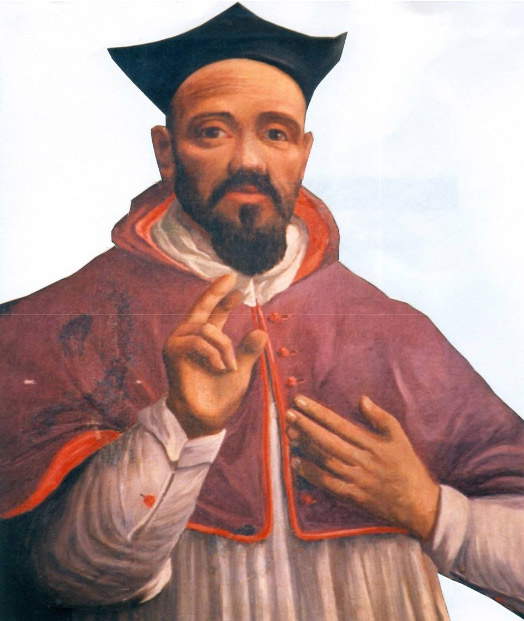 |
| Pasquale Ceci, Posthumous portrait of Vincenzo Giustiniani (19th century; oil on canvas; Gravina, Santa Maria della Grazia) |
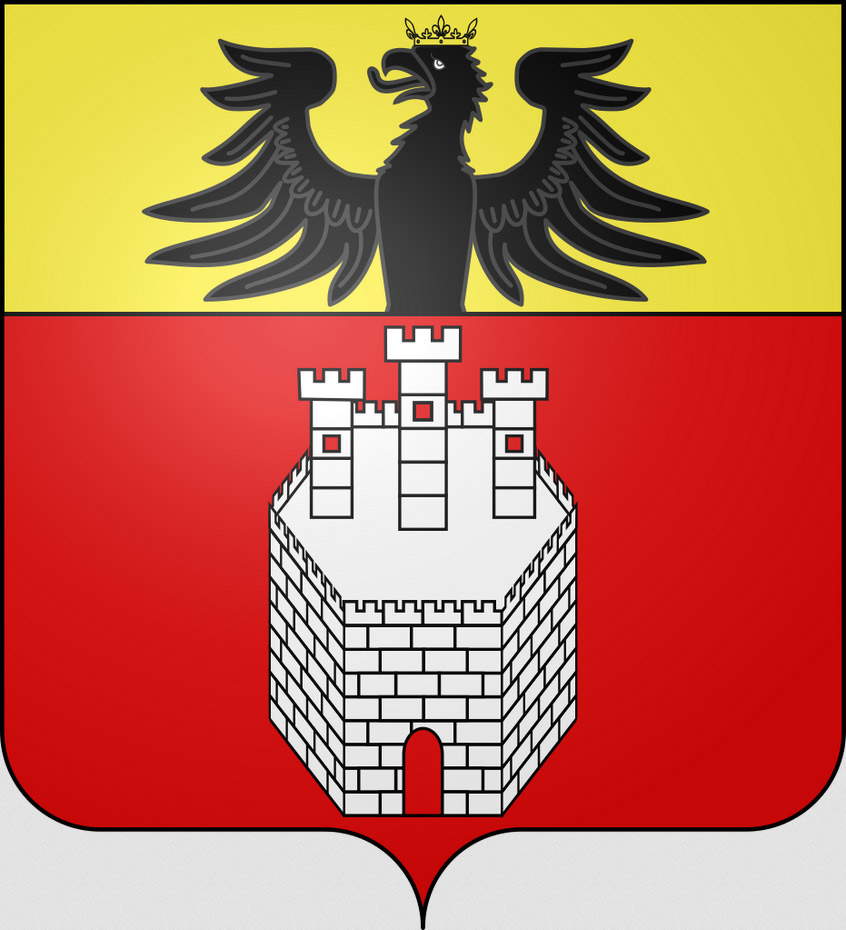 |
| Giustiniani family coat of arms |
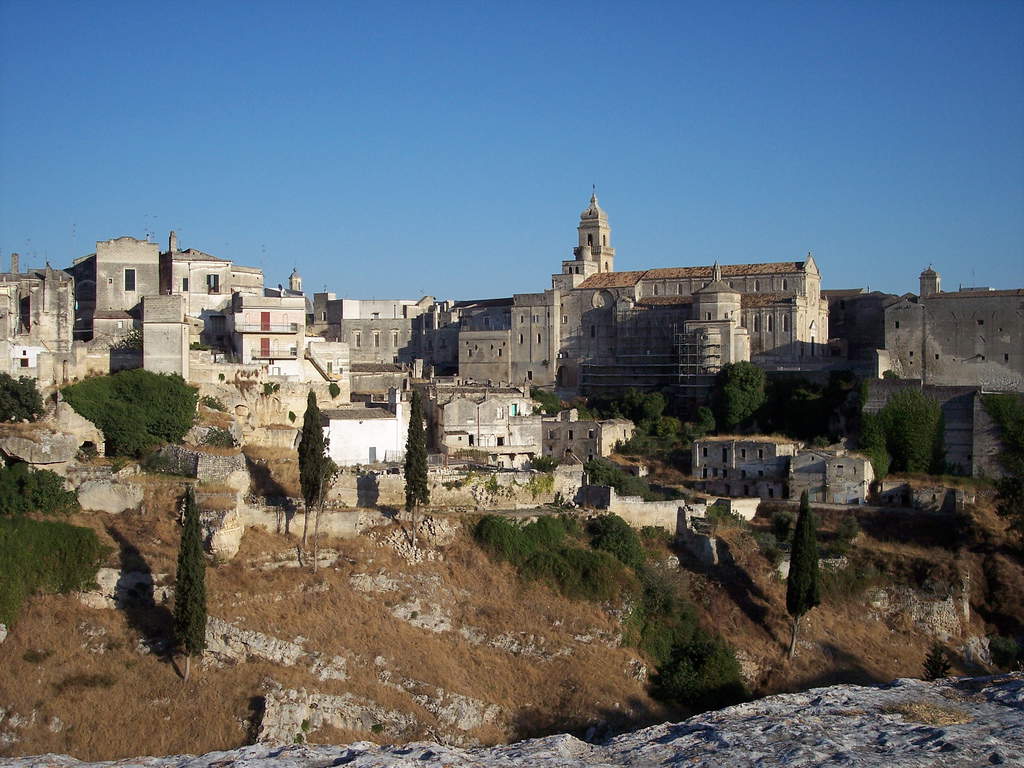 |
| View of Gravina in Puglia. Ph. Credit Luigi Scorcia |
In any case, Giustiniani has remained famous above all for the bizarre church of Santa Maria della Grazia, which has consigned his name to architectural history: in fact, no other such imposing building is known, created to celebrate a family... reproducing its coat of arms on the façade on such a monumental scale. The story begins in 1595, the year in which the bishop of Gravina visited some country chapels outside the city: Giustiniani was struck by the devotion that the inhabitants of the rural areas of this strip of Apulia nurtured towards an image of the Madonna located inside a small chapel that nonetheless attracted a great many worshippers. In a document from 1568, this chapel is mentioned as “Santa Maria la gratia alias de Cardone”: Cardone is most likely the name of the person who built it. In order to improve the reception, the bishop decided to give the people of Gravina a larger church: therefore, in February 1595, theprocess of building a church dedicated to the Virgin of Grace, to be placed on the site of the chapel, outside the city walls, was begun. Work began at the turn of 1597-1598 and was completed a few years later, in 1602. We can only imagine the astonishment of the inhabitants of Gravina on seeing the completed church. The facade, in fact, was (and still is) divided into two parts: in the lower register, large ashlar ashlars applied to the wall recreate the shape of a castle, whose towers correspond to the building’s three access doors. A huge stone eagle with spread wings soars above the central tower, while a stone bishop’s mitre is inserted in the center of the broken tympanum that closes the facade. The design corresponds exactly to that of the Giustiniani coat of arms, where we see, similarly, an eagle surmounting a castle with three towers.
Nonetheless, Vincenzo Giustiniani was very adept at forestalling the criticism that, inevitably, the faithful would level at him: could he, a temple consecrated to God, celebrate in such a blatant and truncated manner the lineage of the bishop who had it built? Lest it appear that his was a blatant sin of pride, the bishop of Gravina also invented some sort of religious just ification for the more than cumbersome presence, in the facade, of what was, in fact, his coat of arms. Thus, Giustiniani had a passage from Deuteronomy (32:11) engraved in Latin in an area of the façade that could be easily observed by anyone: “sicut aquila provocans ad volandum pullos suos et super eos volitans expandit alas suas et portat eos” (“as the eagle exhorts its chicks to fly by flying above them, it spreads its wings and carries them on itself”). The “explanation” of the castle, on the other hand, comes from Psalm 60: “Turris, fortitudinis a facie nemici” (“Tower firm in the face of enemies”). The entire facade, in essence, takes the form of an invitation to strengthen faith. The façade is counterbalanced by a very sober, almost bare interior: three naves with few ornaments, and which are presented with the arrangement they have obtained over time, since the church of Santa Maria della Grazia has been remodeled several times due to collapses that have affected it over the centuries.
Despite the motivations that Bishop Giustiniani offered to the faithful with the inscriptions on the façade, which seek to tone down the façade’s self-celebratory tone, architectural historian Aurora Scotti, who discussed the church of Santa Maria della Grazia in Gravina in Puglia in the volume devoted to the seventeenth century in her History of Architecture, has no doubts: here, Scotti points out, “the message of the commissioning power is expressed in the highest communicative poignancy through a festive, and perhaps ambiguously playful, manipulation of local building craftsmanship. More than a cultic architecture, this facade, adhering to a precise iconological program in which the self-celebratory intentionality of the patron is recognized, addresses the entire city. The church, in fact, located extra moenia, presents itself toward the town with an obvious, well-thought-out message of great appeal.”
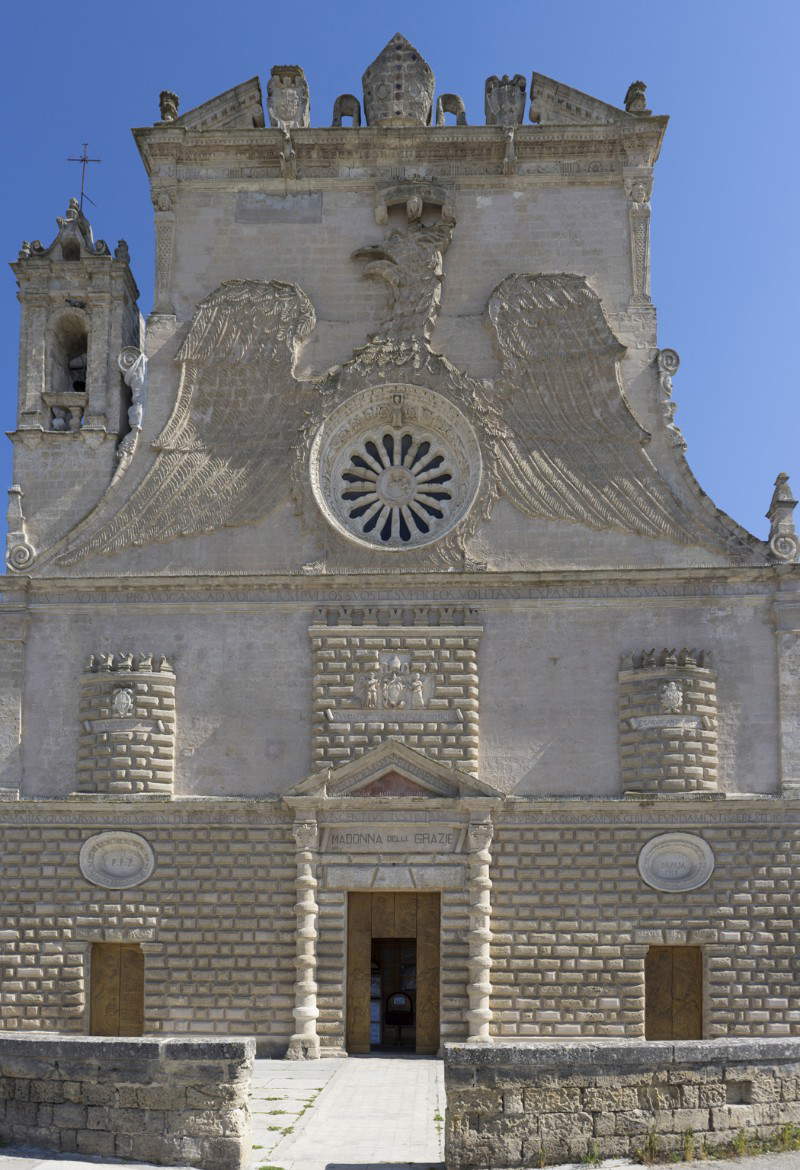 |
| The facade of the church of Santa Maria della Grazia in Gravina in Puglia. Ph. Credit BeWeB |
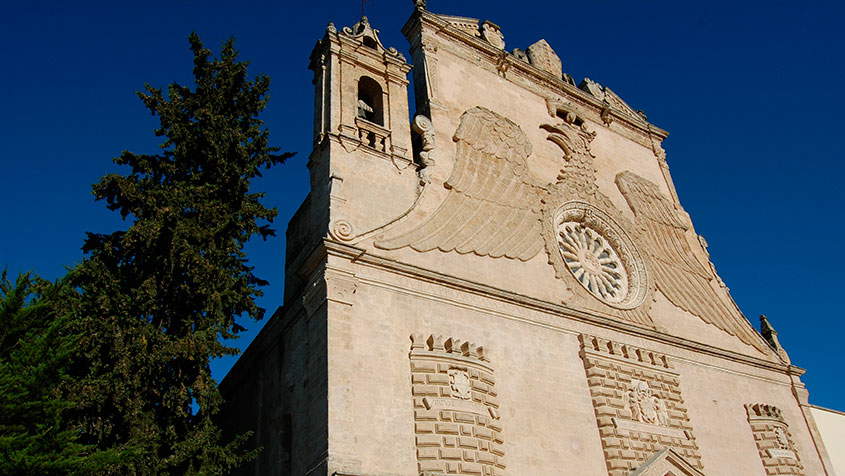 |
| Detail of the facade. Ph. Credit IAT Gravina in Puglia |
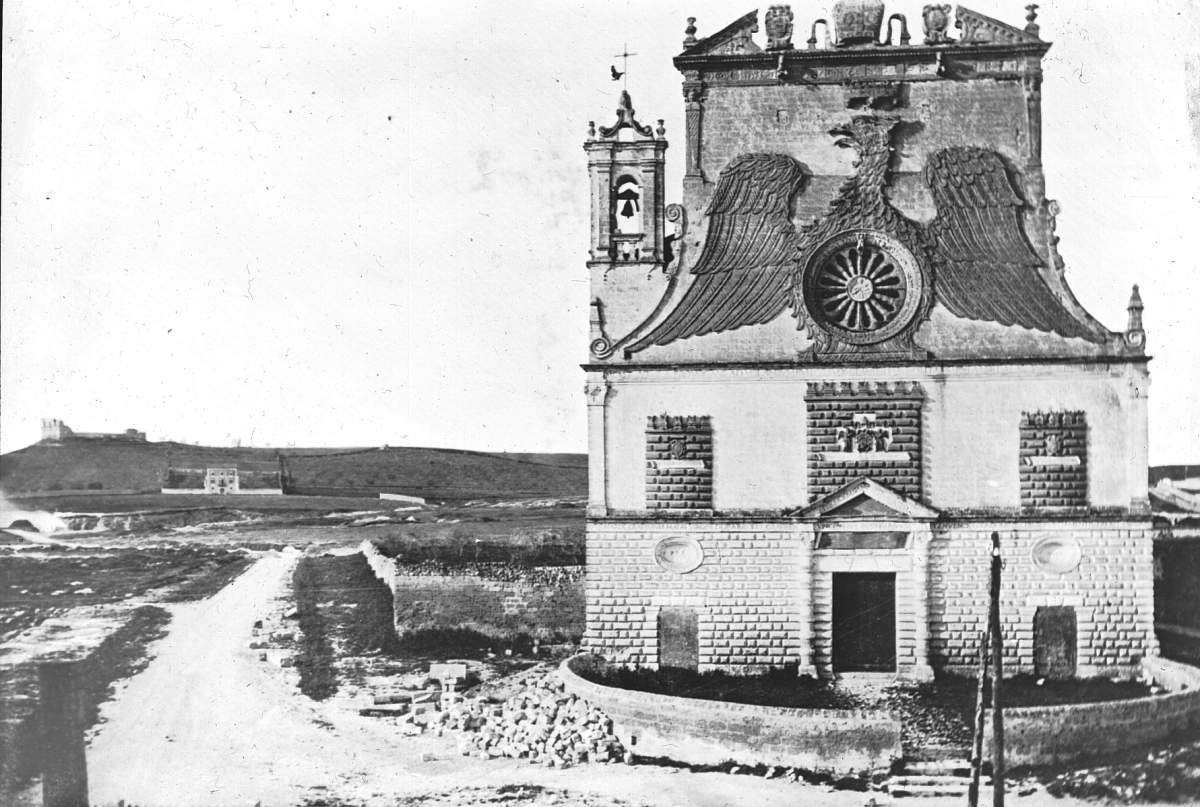 |
| The facade of Santa Maria della Grazia in Gravina in Puglia in the 19th century, in a photo by William Henry Goodyear |
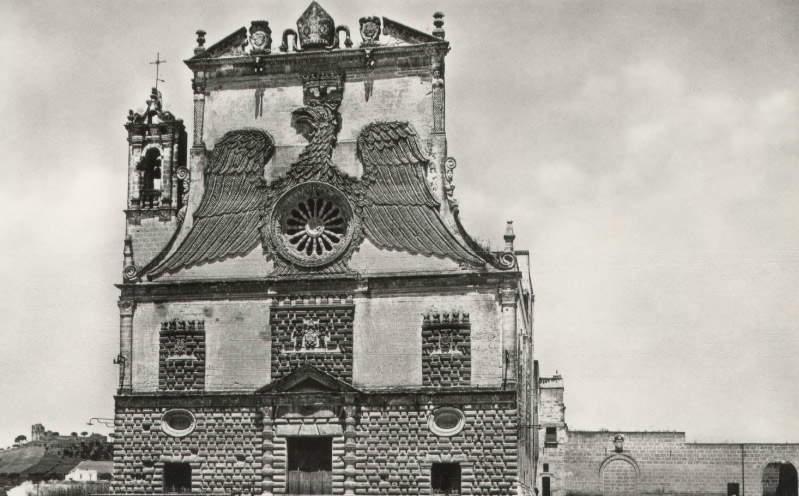 |
| The facade of Santa Maria della Grazia in Gravina in Puglia in the 19th century. |
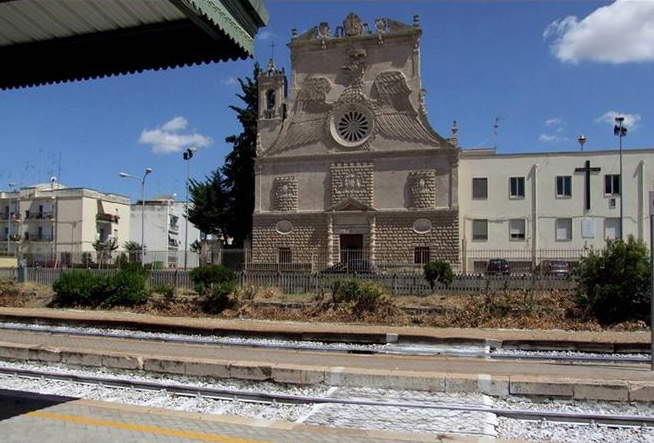 |
| The church today, behind the train station |
Despite the uniqueness of its architecture, the church of Santa Maria della Grazia in Gravina di Puglia has had a very tribulated history, since as early as the seventeenth century, since as early as a few years after the death of Vincenzo Giustiniani it experienced several years of neglect. However, in the mid-17th century, Bishop Domenico Cennini worked to restore both the church and the building that Giustiniani had built next to it (it had the function of an ecclesiastical residence): the faithful, meanwhile, continued to show their devotion to Our Lady of Grace through conspicuous bequests to the church, but its defiladed location was also the cause of numerous thefts that affected the building over the centuries. In addition, the church was also used as a barracks, fell into a state of neglect on several occasions, was closed to worship for a long time (it would only return to its function in 1951), and in 1980 had to suffer damage from the Irpinia earthquake, so much so that massive restoration was necessary. What changed its enjoyability irreparably, however, was the construction of the railroad at the end of the 19th century: the route of the tracks was made to pass right in front of the church, which in a few years saw not only the rails rise up in front of it, but also the Gravina in Puglia train station and all the buildings attached to it (even, in 1912, the Cathedral Chapter asked the state for damages for the landscape havoc). As if that were not enough, in recent times a modern building was attached to the extraordinary facade.
The church of Santa Maria della Grazia is therefore a work that has suffered greatly and deserves to be rediscovered as one of the most interesting monuments not only in Apulia, but in all of Italy: moreover, according to some art historians, its eccentric facade can be considered as a kind of anticipation of the Lecce Baroque. Its exceptionality has led it to be considered, moreover, a property of considerable historical-artistic interest by the Ministry of Cultural Heritage (the bond dates back to 1984). Information on Gravina in Puglia can be found on the website of the regional tourism board, while a vast directory of news and sources on the church of Santa Maria della Grazia is maintained by theBenedict XIII Cultural Association, which has published many documents on the sacred building on its website.
Warning: the translation into English of the original Italian article was created using automatic tools. We undertake to review all articles, but we do not guarantee the total absence of inaccuracies in the translation due to the program. You can find the original by clicking on the ITA button. If you find any mistake,please contact us.






























